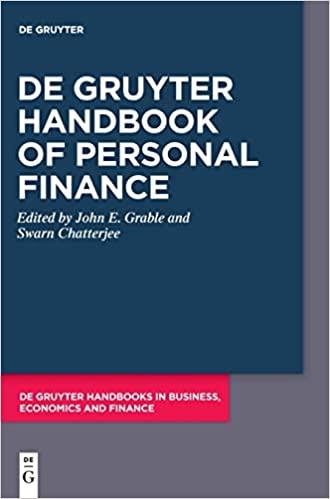Answered step by step
Verified Expert Solution
Question
1 Approved Answer
Quantitative Problem 1. You would like to enter into a contract which specifies that you will purchase $120 million of bonds with an interest rate
Quantitative Problem
1. You would like to enter into a contract which specifies that you will purchase $120 million of bonds
with an interest rate equal to the current interest rate six months from now.
2. You would enter into a contract that specifies that you will sell the $25 million of 8s of 2015 at a
price of 110 one year from now.
3. The futures price must fall to 101. Otherwise, arbitrageurs would buy the bond for 101, sell the future
contract at 102 and then deliver the bond, thereby making a risk-free profit of 1 point. This is such a
good deal that huge sales of the futures contract will result, driving down its price to 101 so that no
risk-free profits can be made.
4. You have a loss of 6 points, or $6000, per contract.
5. You would buy a $100 million worth, i.e. 1000 contracts, of long-term bond futures contract with an
expiration date of one year in the future. This means that you would be entitled to delivery of the
long-term bond at todays price so that the current rate would be locked in.
6. You would buy $100 million worth (1000 contracts) of the call long-term bond option with a delivery
date of one year in the future and with a strike price that corresponds to a yield of 8%. This means that
you would have the option to buy the long bond with the 8% interest rate, thereby making sure that you
can earn the 8%. The disadvantage of the options contract is that you have to pay a premium that
you would not have to pay with a futures contract. The advantage of the options contract is that if the
interest rate rises and the bond price falls during the next year, you do not have to exercise the option
and so will be able to earn a higher rate than 8% when the funds come in next year, whereas with the
futures contract, you have to take delivery of the bond and will only earn 8%.
7. The put option is out of the money because you would not want to take the option to sell the futures
at 95 when the price at expiration is 120. Since the premium is $4,000 and you did not exercise the
contract, your loss on the contract is $4,000.
8. You have a profit of 1 point ($1000) when you exercise the contract, but you have paid a premium of
$1500 for the call option, so your net profit is $500, a loss of $500.
9. Because an option has the feature that you win big if the price has a large change in one direction but
dont lose big if the price has a large change in the other direction. More volatility of the price means
that on average you will have a larger profit because you are more likely to win big with either a call
or a put option and thus their premiums will be higher.
10. It would swap interest on $42 million of fixed-rate assets for the interest on $42 million of variablerate assets, thereby eliminating its income gap.
148 Mishkin/Eakins Financial Markets and Institutions, Sixth Edition
11. You would buy 200 million euros of future March futures contracts. With a contract size of
125,000 euros you would buy 200 million/125,000 = 1600 contracts.
12. You would hedge the risk by buying 80 euro futures contracts that mature 3 months from now.
13. You would want to enter into a contract in which you deliver 30 million euros six months from now
in exchange for U.S. $30 million.
Step by Step Solution
There are 3 Steps involved in it
Step: 1

Get Instant Access to Expert-Tailored Solutions
See step-by-step solutions with expert insights and AI powered tools for academic success
Step: 2

Step: 3

Ace Your Homework with AI
Get the answers you need in no time with our AI-driven, step-by-step assistance
Get Started


